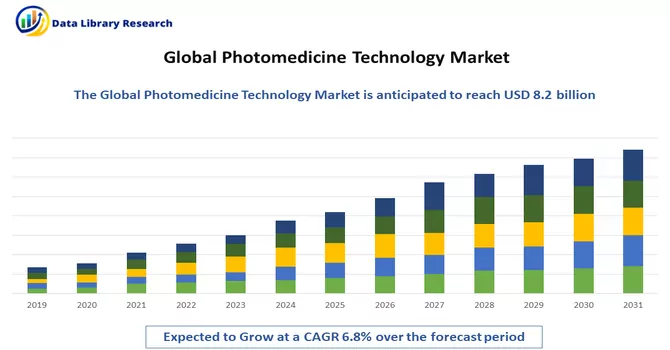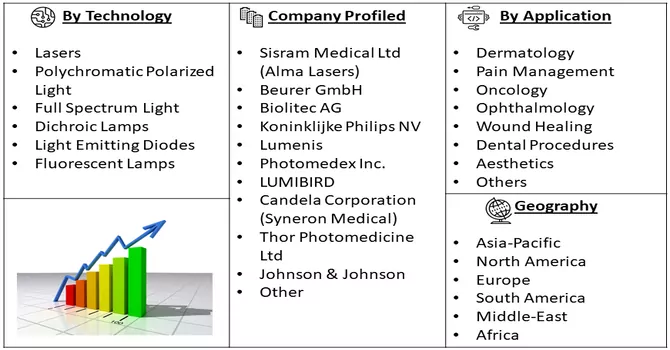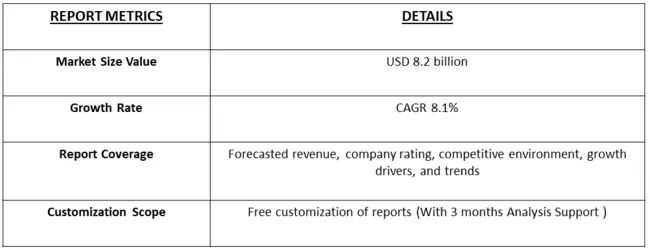The photomedicine market size is expected to reach USD 8.2 billion in 2023 and is expected to register a CAGR of 8.1% over the forecast period, 2024-2031.

Get Complete Analysis Of The Report - Download Free Sample PDF
The photomedicine technology market emerges as a transformative sector within the healthcare landscape, integrating light-based technologies for diagnostic, therapeutic, and aesthetic applications. This innovative field encompasses a spectrum of technologies, including lasers, intense pulsed light, photodynamic therapy, and low-level laser therapy, among others. Photomedicine finds applications in various medical disciplines, ranging from dermatology and ophthalmology to oncology and dentistry.
The market is driven by the increasing adoption of non-invasive and precision-based treatments, coupled with the growing prevalence of skin disorders, cancers, and chronic diseases globally. Advancements in light-based technologies, such as improved wavelength specificity and targeted delivery systems, propel the market's evolution. Moreover, the expanding interest in aesthetic procedures, driven by consumer demand for non-surgical interventions, further contributes to the market's growth. As research and development endeavours continue to advance, the photomedicine technology market is poised to play a pivotal role in shaping the future of medical diagnostics and therapeutic interventions across diverse medical specialities.
A primary growth-driving factor for the photomedicine technology market is the increasing demand for non-invasive and precise medical interventions across various medical disciplines. The advancements in light-based technologies, including lasers, intense pulsed light, and photodynamic therapy, offer a spectrum of treatment options with reduced invasiveness, shorter recovery times, and enhanced precision. This is particularly crucial in fields like dermatology, ophthalmology, and oncology, where targeted and non-surgical approaches are highly valued. Additionally, the growing prevalence of skin disorders, cancers, and chronic diseases worldwide amplifies the need for advanced diagnostic and therapeutic solutions, further propelling the adoption of photomedicine technologies. The market is also driven by the expanding interest in aesthetic procedures, fueled by consumer preferences for non-surgical cosmetic interventions. As these technologies continue to evolve, providing more tailored and effective solutions, the photomedicine technology market is poised to witness sustained growth, playing a pivotal role in reshaping modern medical practices.
Market Segmentation: The Photomedicine Technology Market is Segmented by Application (Aesthetics and Dermatology, Dental Procedures, Oncology, Ophthalmology, Pain Management, Wound Healing, and Other Applications) and Geography (North America, Europe, Asia-Pacific, Middle East and Africa, and South America). The report offers the value (in USD million) for the above segments.

For Detailed Market Segmentation - Download Free Sample PDF
Market trends in the photomedicine technology sector are characterized by continuous innovation, expanding applications, and a growing emphasis on personalized and non-invasive medical interventions. Technological advancements, such as improvements in wavelength specificity, enhanced targeting capabilities, and the development of portable devices, are driving the evolution of photomedicine technologies. The market is witnessing a notable surge in applications across diverse medical specialities, including dermatology, ophthalmology, and oncology, with a focus on providing precise and tailored treatments. The rising popularity of aesthetic procedures, driven by the demand for non-surgical cosmetic interventions, contributes to the market's growth. Furthermore, the integration of artificial intelligence and machine learning in photomedicine enhances diagnostic accuracy and treatment planning. The convergence of technology and healthcare is evident in the increasing adoption of telemedicine and remote monitoring, further shaping the market's trajectory. As research and development efforts persist, the photomedicine technology market trends toward more sophisticated and patient-centric solutions, reaffirming its role in the forefront of transformative medical technologies.
Market Drivers:
The rising preference for non-invasive treatments across various medical specialities
The increasing preference for non-invasive treatments represents a pivotal shift in modern healthcare practices across various medical specialities. Patients and healthcare providers are increasingly opting for interventions that minimize the need for surgical procedures, offering several advantages such as reduced recovery times, lower risk of complications, and enhanced patient comfort. This trend is particularly notable in medical disciplines like dermatology, where laser therapies and light-based treatments are gaining prominence for skin conditions, and in ophthalmology, where non-invasive techniques contribute to improved eye health. Additionally, the field of aesthetic medicine witnesses a surge in demand for non-surgical cosmetic procedures, reflecting a broader societal inclination toward minimally invasive yet effective interventions. The rise of non-invasive treatments aligns with the broader goals of patient-centric care, emphasizing outcomes that optimize both medical effectiveness and patient experience across diverse medical specialities. As technology continues to advance, the healthcare landscape is evolving to accommodate and prioritize these non-invasive approaches, marking a transformative trend in modern medical practice.
The relentless progression of light-based technologies
The relentless progression of light-based technologies stands as a driving force behind transformative advancements in various medical disciplines. From lasers and intense pulsed light to innovative photodynamic therapies, the continuous evolution of these technologies is reshaping diagnostic and therapeutic landscapes. In dermatology, precise laser treatments address skin conditions with heightened accuracy, while in ophthalmology, advancements in light-based imaging enhance diagnostic capabilities. Beyond diagnostics, light-based therapies are pivotal in fields like oncology, where photodynamic therapy offers targeted treatment options. The versatility and precision of these technologies contribute to their growing applications, marking significant strides in medical innovation. Ongoing research and development efforts focus on refining these technologies, improving safety profiles, and expanding their utility across diverse medical specialities. As the relentless progression of light-based technologies continues, it not only underscores the dynamic nature of medical advancements but also promises to redefine standards of care, offering more effective and personalized solutions for patients worldwide.
Market Restraints:
Several market restraints present challenges to the photomedicine technology market. One significant factor is the high initial costs associated with acquiring and implementing advanced photomedicine technologies. The substantial investment required for purchasing state-of-the-art equipment and ensuring staff training can be a deterrent for healthcare facilities, limiting widespread adoption. Additionally, regulatory complexities and varying approval processes across regions pose challenges for market players in introducing new photomedicine technologies to different markets. Another restraint is the potential for adverse effects or complications associated with certain light-based therapies, requiring careful consideration of patient safety and regulatory compliance. Limited reimbursement policies for specific photomedicine procedures may hinder widespread patient access, impacting market growth. Moreover, the intricate nature of certain medical conditions may necessitate extensive clinical validation and studies, delaying the introduction of new technologies to the market. These multifaceted challenges collectively shape the landscape of the photomedicine technology market, highlighting the need for strategic approaches to address these constraints and promote sustainable growth within the industry.
The COVID-19 pandemic has imparted both challenges and opportunities to the photomedicine technology market. Disruptions in healthcare systems, the redirection of resources toward pandemic management, and the implementation of safety measures have led to delays in elective procedures, impacting the adoption of certain photomedicine technologies. However, the pandemic has also underscored the importance of non-invasive and remote medical interventions, aligning with the characteristics of many light-based therapies. Telemedicine and virtual consultations gained prominence, facilitating the continuity of care for certain photomedicine applications, such as dermatological consultations and follow-ups. The heightened focus on hygiene and safety protocols also accelerated the adoption of contactless technologies, positively influencing the acceptance of non-invasive photomedicine solutions. While the pandemic presented challenges, it simultaneously highlighted the adaptability and resilience of the photomedicine technology market, fostering innovation and prompting a reevaluation of healthcare practices to better align with evolving global health needs.
Segmental Analysis:
Oncology Segment is Expected to Witness Significant Growth Over the Forecast Period
Oncology, the branch of medicine dedicated to the study and treatment of cancer, has seen promising advancements with the integration of photomedicine. Photomedicine in oncology involves the application of light-based technologies, such as photodynamic therapy and laser therapy, to diagnose, treat, and manage various types of cancer. These innovative approaches leverage the interaction between light and photosensitive agents to target cancer cells selectively. Photomedicine not only offers potential alternatives to traditional cancer treatments but also provides less invasive options with reduced side effects. The evolving field of oncology and photomedicine showcases a convergence of cutting-edge technologies aimed at improving cancer outcomes and enhancing the quality of life for patients undergoing cancer therapy.
North America Region is Expected to Witness Significant Growth Over the Forecast Period
The North American region is poised for substantial growth in the field of photomedicine, primarily attributed to multiple factors. The region's increasing incidence of cancer, coupled with a rising preference for laser-based treatments, underscores the demand for advanced therapeutic solutions. The robust presence of industry players in North America, particularly the United States, is complemented by superior healthcare infrastructure and a heightened awareness among both the general public and healthcare professionals about available technologies. The American Cancer Society's 2022 update reported a staggering 1.9 million new cancer cases in the United States, with breast cancer alone accounting for 290,560 new cases. Given that photomedicine plays a crucial role in cancer treatment, the high prevalence of cancer in the region is expected to drive market growth.
Furthermore, advancements in technology, coupled with increased product approvals, partnerships, and collaborations by key market players, contribute significantly to the region's expanding photomedicine market. A notable example is Solta Medical's introduction of the Clear + Brilliant Touch laser in the United States in March 2021, providing a tailored and comprehensive treatment protocol for patients of all ages and skin types through the utilization of two wavelengths. Such regulatory approvals are anticipated to further boost the adoption of photomedicine technologies in the region. Additionally, the commitment of organizations like the Wellman Center for Photomedicine at Massachusetts General Hospital to research and discover new diagnostic and therapeutic applications of light is expected to fuel the market's growth over the forecast period, showcasing the continuous evolution and innovation in the field of photomedicine in North America.

Get Complete Analysis Of The Report - Download Free Sample PDF
The analyzed market exhibits a high degree of fragmentation, primarily attributable to the presence of numerous players operating on both a global and regional scale. The competitive landscape is characterized by a diverse array of companies, each contributing to the overall market dynamics. This fragmentation arises from the existence of specialized solution providers, established industry players, and emerging entrants, all vying for market share. The diversity in market participants is underscored by the adoption of various strategies aimed at expanding the company presence. On a global scale, companies within the studied market are strategically positioning themselves through aggressive expansion initiatives. This often involves entering new geographical regions, targeting untapped markets, and establishing a robust global footprint. The pursuit of global expansion is driven by the recognition of diverse market opportunities and the desire to capitalize on emerging trends and demands across different regions. Simultaneously, at the regional level, companies are tailoring their approaches to align with local market dynamics. Regional players are leveraging their understanding of specific market nuances, regulatory environments, and consumer preferences to gain a competitive edge. This regional focus allows companies to cater to the unique needs of local clientele, fostering stronger market penetration. To navigate the complexities of the fragmented market, companies are implementing a range of strategies. These strategies include investments in research and development to stay at the forefront of technological advancements, mergers and acquisitions to consolidate market share, strategic partnerships for synergies, and innovation to differentiate products and services. The adoption of such multifaceted strategies reflects the competitive nature of the market, with participants continually seeking avenues for growth and sustainability. In essence, the high fragmentation in the studied market not only signifies the diversity of players but also underscores the dynamism and competitiveness that drive ongoing strategic maneuvers. As companies explore various avenues for expansion, the market continues to evolve, presenting both challenges and opportunities for industry stakeholders.
Some of the key market players are:
Recent Development:
1) In 2022 Biolase specifically invites studies in pediatric dentistry, endodontics, periodontics, implantology, and photobiomodulation (PBM), with the goal of advancing minimally invasive laser technology within these specialized fields. The establishment of this portal underscores Biolase's commitment to fostering research collaborations and driving innovation in laser applications across diverse areas of dental care.
2) In October 2022, Multi Radiance Medical achieved FDA clearance for its FibroLux therapy laser, marking a significant milestone. This clearance validates the device's effectiveness in treating pain associated with fibromyalgia, offering a non-invasive and potentially impactful therapeutic option for individuals dealing with this challenging condition. Multi Radiance Medical's FibroLux therapy laser approval reflects the company's dedication to expanding the clinical applications of its technologies, contributing to advancements in pain management and underscoring the importance of innovative approaches in addressing complex medical conditions.
Q1. What was the Photomedicine Technology Market size in 2023?
As per Data Library Research the photomedicine market size is expected to reach USD 8.2 billion in 2023.
Q2. At what CAGR is the Photomedicine Technology market projected to grow within the forecast period?
Photomedicine Technology Market is expected to register a CAGR of 8.1% over the forecast period
Q3. What are the factors driving the Photomedicine Technology market?
Key factors that are driving the growth include The rising preference for non-invasive treatments across various medical specialities and The relentless progression of light-based technologies.
Q4. Which Region is expected to hold the highest Market share?
North America region is expected to hold the highest Market share.
Data Library Research are conducted by industry experts who offer insight on industry structure, market segmentations technology assessment and competitive landscape (CL), and penetration, as well as on emerging trends. Their analysis is based on primary interviews (~ 80%) and secondary research (~ 20%) as well as years of professional expertise in their respective industries. Adding to this, by analysing historical trends and current market positions, our analysts predict where the market will be headed for the next five years. Furthermore, the varying trends of segment & categories geographically presented are also studied and the estimated based on the primary & secondary research.
In this particular report from the supply side Data Library Research has conducted primary surveys (interviews) with the key level executives (VP, CEO’s, Marketing Director, Business Development Manager and SOFT) of the companies that active & prominent as well as the midsized organization
FIGURE 1: DLR RESEARH PROCESS

Extensive primary research was conducted to gain a deeper insight of the market and industry performance. The analysis is based on both primary and secondary research as well as years of professional expertise in the respective industries.
In addition to analysing current and historical trends, our analysts predict where the market is headed over the next five years.
It varies by segment for these categories geographically presented in the list of market tables. Speaking about this particular report we have conducted primary surveys (interviews) with the key level executives (VP, CEO’s, Marketing Director, Business Development Manager and many more) of the major players active in the market.
Secondary ResearchSecondary research was mainly used to collect and identify information useful for the extensive, technical, market-oriented, and Friend’s study of the Global Extra Neutral Alcohol. It was also used to obtain key information about major players, market classification and segmentation according to the industry trends, geographical markets, and developments related to the market and technology perspectives. For this study, analysts have gathered information from various credible sources, such as annual reports, sec filings, journals, white papers, SOFT presentations, and company web sites.
Market Size EstimationBoth, top-down and bottom-up approaches were used to estimate and validate the size of the Global market and to estimate the size of various other dependent submarkets in the overall Extra Neutral Alcohol. The key players in the market were identified through secondary research and their market contributions in the respective geographies were determined through primary and secondary research.
Forecast Model
